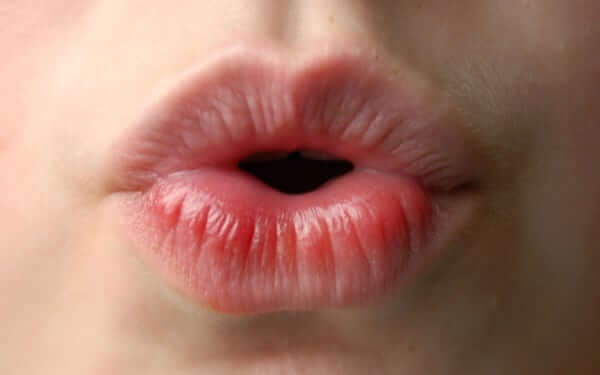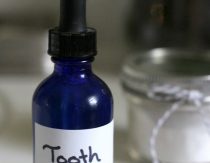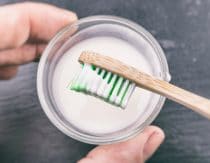
The tale of how I came to shun toothpaste (even “natural toothpaste”) is a somewhat convoluted one. It started about ten months ago when, on our way back from a service celebrating Papaw Dessinger’s life, Katie’s front tooth broke.
No trauma. No fall. It just broke.
What had happened to my otherwise healthy, robust child? Turns out, Katie had a lip tie (same as my son’s) that caused milk to pool near her top four teeth in the front, causing a breastmilk version of “bottle rot.”
I felt horrible, confused, and embarrassed. You name it, I felt it.
Every time Katie smiled in public I felt the sting of the expressions I’d see on other people’s faces. How could I let my child walk around like this without doing something? The thing is, I wanted to do something, but I knew that although dental procedures could cosmetically correct the problem, they couldn’t strengthen her teeth. I wanted to know how we could correct the problem naturally, so I began researching ways to build up Katie’s teeth and bones. Food had been a healing force in my life and I believed it could do the same for my daughter.
My AHA! Moment
After scouring the web I ran across someone who had been through the exact same experience with his own daughter. Ramiel Nagel, author of Cure Tooth Decay, had successfully helped his daughter’s cavities heal using food. I had never heard of such a thing! Apparently, the tooth structure that had decayed didn’t fully grow back it’s original structure, but the decay disappeared and new enamel formed to seal and protect what was left of the tooth. Amazing.
The days spent waiting for Amazon to deliver my precious package stretched my patience, but when it finally arrived I knew it had been worth the wait before I finished the intro:
“Decaying teeth can be a scary, painful process. When in a state of fear and panic, we disregard the most sensible decision we could make: to search for the real cause, rather than succumb to the easy and passive response of allowing a dentist to “fix” the problem for us. We have been taught, for the most part, that tooth decay is inevitable and that we have no choice in the matter. After reading this book you will see that this is far from the truth.”
The book is based on the research of Dr. Weston Price, a figure whose findings had played a prominent role on my own journey from chronic disease to vibrant health. Dr. Price was a prominent dentist that traveled the world in the 1930s to study why indigenous cultures have stronger teeth and fewer cavities than modern “civilized” cultures. Dr. Price was no quack. In fact, he was the first research director of the National Dental Association, which later became The American Dental Association (ADA).
During the 1930s, Dr. Price was able to document the sharp decline in health experienced by previously healthy people who came into contact with modern civilization. The revealing findings of Dr. Price, along with his telling photographs, bring home the fact that our modern food and lifestyle is a primary cause of disease.
Cure Tooth Decay, p. 24
Despite our zillions of toothpastes, mouthwashes, flavored flosses, etc. we are actually worse off than many “primitive” cultures when it comes to dental health. We have more cavities, more gum disease, and more need for braces.
How can that be?
Dr. Price found that traditional diets were significantly higher in fat-soluble vitamins (A, D, E &K), calcium and phosphorous. As tooth enamel wears away these nutrients are needed to replenish it (often referred to as tooth remineralization). Unfortunately, since the modern diet is typically deficient in all of these that doesn’t happen. Keep in mind, this research was done back in the 1930s. Although refined sugar, canned vegetables and white flour had already been introduced just think how much worse it is now!
But wait! We’re Real Foodies. We don’t eat a SAD diet.
And if you don’t have tooth decay that may be why. However, I have unfortunately run into several real foodies whose children have similar issues to Katie. So what gives? Obviously, in Katie’s situation an undiagnosed lip tie played a huge role. But aside from that there are other practices that can interfere with tooth remineralization. Like toothpaste.
My personal experience has been that flossing and brushing do help limit tooth decay. The act of brushing may not be harmful, but the use of certain toothpastes (especially those with flouride) could create harmful effects and even promote cavities. Glycerin is added to toothpaste to give it its “pasty” consistency. Supposedly, glycerin requires 27 rinses to remove from the teeth. And this could create a barrier on the teeth that would prevent teeth from getting harder and stronger.
Cure Tooth Decay, p. 123
According to Nagel, remineralization occurs both through direct contact with nutrients when food is chewed and also through digestion/uptake via the bloodstream. By coating our teeth we prevent one of the two ways teeth are designed to remineralize and harden.
In addition, products like tooth whitening gels strip the teeth of their enamel and make them more vulnerable. Manufacturers say whitening products don’t harm enamel, but I have used them and experienced enamel loss firsthand. My teeth did get whiter, but they also lost their sheen, which is the outermost layer of enamel.
What Now, Brush With Tree Bark?
So, if tooth brushing is beneficial but toothpaste is bad, what do we use . . . tree bark??? Yes and No. If you’re teeth are really suffering there are some very beneficial herbal blends that contain bark (White Oak, Prickly Ash, Bayberry and Slippery Elm). But I am getting ahead of myself. There are basically three options: tooth suds, baking soda or herbal tooth powders:
- Tooth Suds – Sold as a liquid or in little flakes that dissolve in your mouth, tooth suds are a gentle cleanser made with castile soap. We make our own using this recipe.
- Baking Soda with Ground Calcium/Magnesium – I blend calcium citrate/magnesium supplements in the coffee grinder and mix with a little natural baking soda. I like to add a drop of essential oil (licorice, peppermint or fennel) to make it more palatable. Use once or twice a week to remove stains. Note: Because baking soda is very alkaline and your mouth needs a certain level of acid to kill bacteria, it is best not to use baking soda every day. If you begin to experience gum sensitivity or bleeding it may mean your mouth is too alkaline and is not killing bacteria properly.
- Herbal Tooth Powders and Liquids – These are especially helpful if you are already experiencing problems with your teeth or gums. They are very healing but can cause discoloration if used long term. Nagel recommends the Tooth & Gum Restore Formula by Dr. Richard Schulze and Dr. Christopher’s Herbal Tooth & Gum Powder.
For natural tooth whitening, Nagel makes this recommendation:
Dab a small amount of organic peppermint essential oil on your finger (much less than a drop), rub your finger on your toothbrush, and then brush normally.
My dentist friend and his wife are going to be horrified when they read this, but things got worse with Katie’s teeth before they got better. She got two cavities in her bottom molars. Although I am not a dentist and never had one confirm that she had cavities, I worked as a dental assistant for my friend for a brief period during college and I’m 100% sure that she had two.
When I found them I decided to hold off on an exam and order both of the herbal formulas I mentioned. Katie hates them both, but she hates Dr. Christopher’s Herbal Tooth & Gum Powder less. Since I began using it one cavity has healed completely (with new white enamel over the top) and one has gone from a scary black spot to a light brown one that looks better all the time. Overall, the quality of the enamel on her teeth has also significantly improved. They went from looking slightly translucent at the tips to being more dense looking.
We still have a ways to go, but I think that’s mostly because I can only get her cooperation part of the time when it comes to eating certain healing foods. Overall, though, I feel very strongly that because of Nagel’s book she will suffer no long term effects due to my previous ignorance. Her baby teeth may not be as perfect as some other childrens, but her bones and adult teeth will be strong and healthy.
Personally, I have seen significant remineralization with my own teeth since switching to toothsoap, but I have more stains that I’d like. I think I’ll try the peppermint oil and see how it goes.
Click here for an amazing photo update on Katie’s teeth!
Resources:
For more in-depth info visit The Weston A. Price Foundation
FREE Ebook: DIY Body Care Gifts Made Simple
Do you want to give gorgeous, handcrafted gifts for family and friends, without spending a bunch of time on them?
Then I’d love to give you a free copy of DIY Body Care Gifts Made Simple – my step-by-step guide to making gorgeous handcrafted gifts without stressing yourself out – as a gift for signing up for my newsletter. I’ll show you how to make vintage labels, luxurious lotion bars, lip balms, sugar scrubs, body sprays and more like a pro. Sign up for my newsletter and you’ll be redirected to the download page immediately!
Photo credit: Julia Freeman-Woolpert




